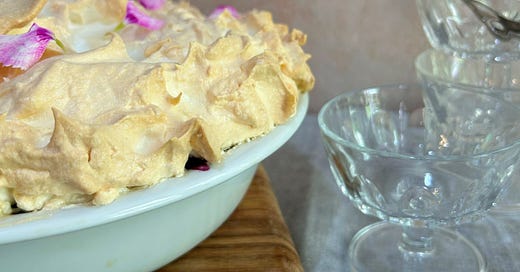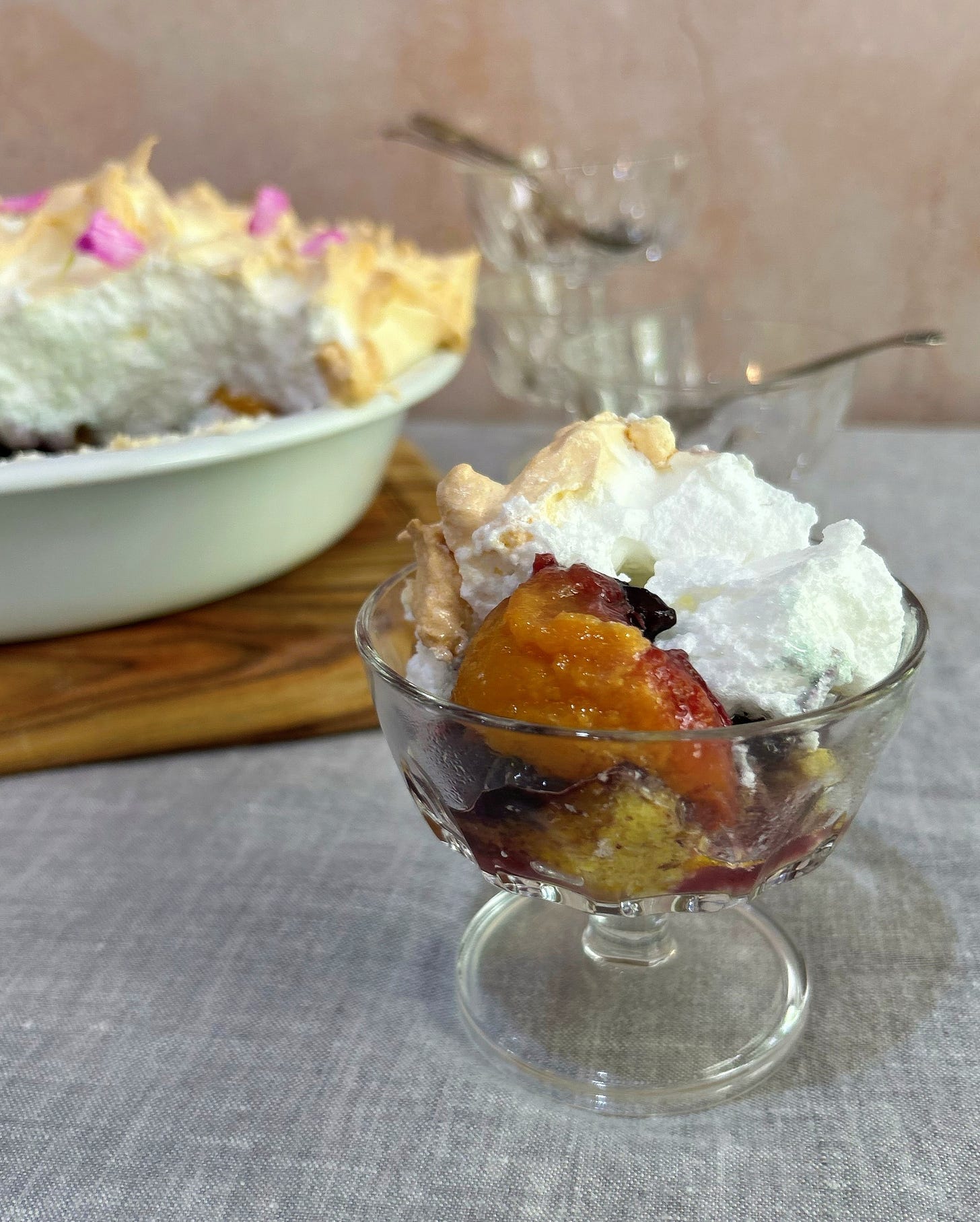our little patch of rural Tassie + peach & blueberry queen of puddings
Home Baked: A Year of Seasonal Baking - Summer
Home Baked: A Year of Seasonal Baking is a cookbook in weekly instalments. A subscription will ensure you don’t miss any of the stories and recipes. Please consider supporting this publication with a paid subscription. You’ll receive printer-friendly recipe cards, bonus recipes, access to Q&A, a quarterly compilation of the recipes, plus an additional Friday newsletter.
For most of my life, I’ve lived in a city. I’ve had a few forays into regional life. I went to university in Armidale in northern New South Wales. In its heart, it was a rural community, overlaid with the culture and sophistication that came with being a university town. It was, in some ways, the best of both worlds, enough of the positives from city life, albeit on a smaller scale. Options for eating out, a range of shops, museums and theatre but in those days no McDonalds! Fast food was still a bit of a novelty, and anyone making the couple of hours round trip to the nearest one in Tamworth was given a list of orders. Needless to say, cold or reheated McDonald’s doesn’t improve it! Armidale also benefitted from its regional location. Wide open spaces were a few minutes drive away, farming life was very much a part of the city’s DNA, and as a result, life was slower than in larger urban areas.
My second regional experience was very different. The result of too much partying and a semester of poor university results meant a short break before I could retake the classes. I ended up nannying in Tieri, a very new, built-from-scratch mining town in central Queensland. Fresh produce was delivered once a week to the only grocery shop. There was a public swimming pool and an entertainment complex that featured comedians and musicians making the rounds of rural locations. Everything was new, a fledgling town with a yet-to-be-formed personality and dominated by well-paid young men who had little to do other than work and party. It was an eye-opening experience!
Then there was Cessnock and my first real job - a trainee town planner. Also a mining town but much older and far less isolated, being only a couple of hours drive from Sydney. It was a relatively short-lived stay. I was poorly paid, lonely, questioning my career choice and never felt at home there.
And now there’s Geeveston. A little speck in southern Tasmania that, although it has some issues, has so much going for it and is such a fabulous place to live. The ‘town’ centre is just off the highway, a compact couple of streets with everything you need for the day-to-day - a small supermarket, hardware, several eating-out options, a chemist, a post office and a library. The Visitor’s Centre is housed in the old town hall that dominates the end of the street, and Heritage Park wraps around the rear of the main street. There are trees and planter boxes with flowers. The footpaths are paved, and wooden statues of people significant to Geeveston’s history are dotted around.
It is a matter of a few hundred metres that separates the ‘town’ proper from the rural surrounds. Farm and bushland encroach with very little distinction, and it’s not much further before you reach the untamed south west national park. It’s vast, and I suspect that there are areas within, completely untouched by humans. The physical attributes of the area are a huge bonus. A few days in the city and I crave the peace and tranquility of rural life. During the day, life plods along, punctuated by animal noises and the occasional vehicle. At night it’s utterly quiet and dark.
However, more than anything, the best thing about regional living is the community and the sense of connection. It can be daunting being in a new place and having to put yourself out there, but we’ve never felt anything other than welcomed. The cliche that everyone in a small place knows what everyone else is doing is mostly true! It’s almost impossible to go down the street without running into someone you know, a simple thing that creates a sense of belonging. People are generous with their invitations, their local knowledge and their homegrown produce.
Regional life isn’t for everyone. It’s easy to get caught up on a holiday or a short visit when only the positives are evident. Covid saw an influx of people romanticising rural living and the benefits of a green change, only to realise it’s not quite what they thought. People say that if you last three or four years, you’ll be fine, but there are plenty of others who move within this timeframe. There are challenges with health care and education. Work opportunities are more limited. Public transport patchy. There can be tensions between long-term residents and those who have moved more recently. There are, however, issues wherever you live and for me, the positives of living here far outlay the negatives. I expected to enjoy our move and to be happy living in a different place; indeed, that’s what moving is often about. But it’s been so much more in ways that I never foresaw. We’ll never be considered locals; we’re decades away from that, but we’re working on it!
By definition, puddings are “a cooked sweet dish served after the main course of a meal.” To me, they are an everyday dish with simple ingredients and a fairly straightforward preparation, and they are most definitely cooked in some way. In contrast, desserts are often far more fancy and cover the whole gamut of sweet meal endings. To my mind, it’s a case of all puddings are desserts, but not all desserts are puddings (although if we are being pedantic, there are savoury puddings!). A pudding is to be enjoyed on a weeknight and should last a few evenings. It could be anything from rice pudding to a fruit crumble, a self-saucing pudding or golden syrup dumplings. Puddings aren’t always suitable for mid-summer; they veer towards warming comfort food that isn’t necessarily what you are looking for at the end of a hot day (although ice cream as an accompaniment rather than custard could make a huge difference!). But where there is a will, there is a way, and I think this summer version of Queen of Puddings might just hit the spot.
Dishes involving breadcrumbs, milk and eggs are plentiful in British cooking history. This recipe for a good quaking bag pudding is from 1699, and the wonderfully named book The Closet of Sir Kenelm Digby Knight Opened:
Set a quart of good morning Milk upon the fire, having seasoned it with Salt, and sliced or grated Nutmeg. When it beginneth to boil, take it from the fire, and put into it four peny Manchets of light French-bread sliced very thin (If it were Kingstone-bread, which is firmer, it must be grated) and a lump of Sweet-butter as big as a Wall-nut, and enough Sugar to season it; and cover the possnet with a plate to keep the heat in, that the bread may soak perfectly. Whiles this standeth thus, take ten yolks of New-laid-eggs, with one White, and beat them very well with a spoonful or two of Milk; and when the Milk is cooled enough, pour it (with the bread in it,) into the bason, where the beaten Eggs are, (which likewise should first be sweetned with Sugar to their proportion,) and put about three spoonfuls of fine flower into the composition, and knead them well together.
The name Queen of Puddings implies royal origins, and it is also claimed that the pudding was made in honour of Queen Victoria, neither of which is true. ‘A queen’s pudding’ made its first appearance in 1865 in Masey and Son’s Comprehensive Pudding Book - a pudding with a base of custard thickened with bread crumbs, a layer of apricot jam and topped with meringue. More recent recipes favour raspberry jam, but I’ve abandoned both options and have gone with a summer combination of blueberry compote and fresh peaches. You can use brioche as I have done in this recipe, but traditionally, fresh white breadcrumbs are used and work perfectly well, and for the amount used, it is certainly not worth buying brioche especially.
Blueberry & Peach Queen of Puddings
Serves 8
Blueberry compote
250 g fresh blueberries (frozen will also work perfectly well)
1 tablespoon sugar
1 teaspoon water
1 teaspoon cornflour
Pudding
600 ml milk
60 g salted butter
140 g fresh, fine brioche or white breadcrumbs
1 tablespoon sugar
1 teaspoon vanilla paste
zest of one large lemon
4 eggs, separated
blueberry compote
3 peaches, stone removed and sliced (you can also use tinned or bottled peaches)
165 g sugar extra
Make the blueberry compote first. Tip the blueberries into a small saucepan with the sugar and water. Cook over a medium heat until they are juicy and have softened. Sprinkle over the cornflour and continue cooking for another minute or two or until the juice has thickened slightly. Cool in the fridge while you prepare the pudding.
Preheat the oven to 170°C.
Put the milk and butter in a medium saucepan and heat until the butter has melted and the milk is not quite boiling.
Tip in the breadcrumbs, tablespoon of sugar, vanilla and lemon and stir. Let sit for 10 minutes. Stir in the egg yolks and then pour into a shallow baking dish. Bake for about 25-30 minutes or until the custard has set but still has a slight wobble.
Towards the end of the cooking time, make the meringue. Put the egg whites into the bowl of a stand mixer and beat until you have soft peaks. Continue beating and add the sugar a little at a time until the meringue is stiff and glossy.
Remove the custard from the oven. Spoon over the blueberry compote and then the sliced peaches. Top with the meringue. I like a more free-form look, but you could pipe the meringue if you prefer and return to the oven for 10-15 minutes or until the meringue is lightly golden. Leave to cool and serve slightly warm or at room temperature.
Next time: the things that grow wild + shortbread with nectarine glaze & fennel pollen
Join me, avid baker and occasional rule breaker, as I share my love of baking, adapting what we bake to suit the seasons. Your support for this project is greatly appreciated. Each weekly post is available to all subscribers.
For paid subscribers, a printer-friendly recipe card for the blueberry & peach queen of puddings is below. There’s also a short video, a bit of a wander through the veggie patch, to give you a bit of an idea of how things are growing. As a paid subscriber, you receive this bonus material as well as an additional newsletter each Friday.
Keep reading with a 7-day free trial
Subscribe to Apples & Elderflower to keep reading this post and get 7 days of free access to the full post archives.








